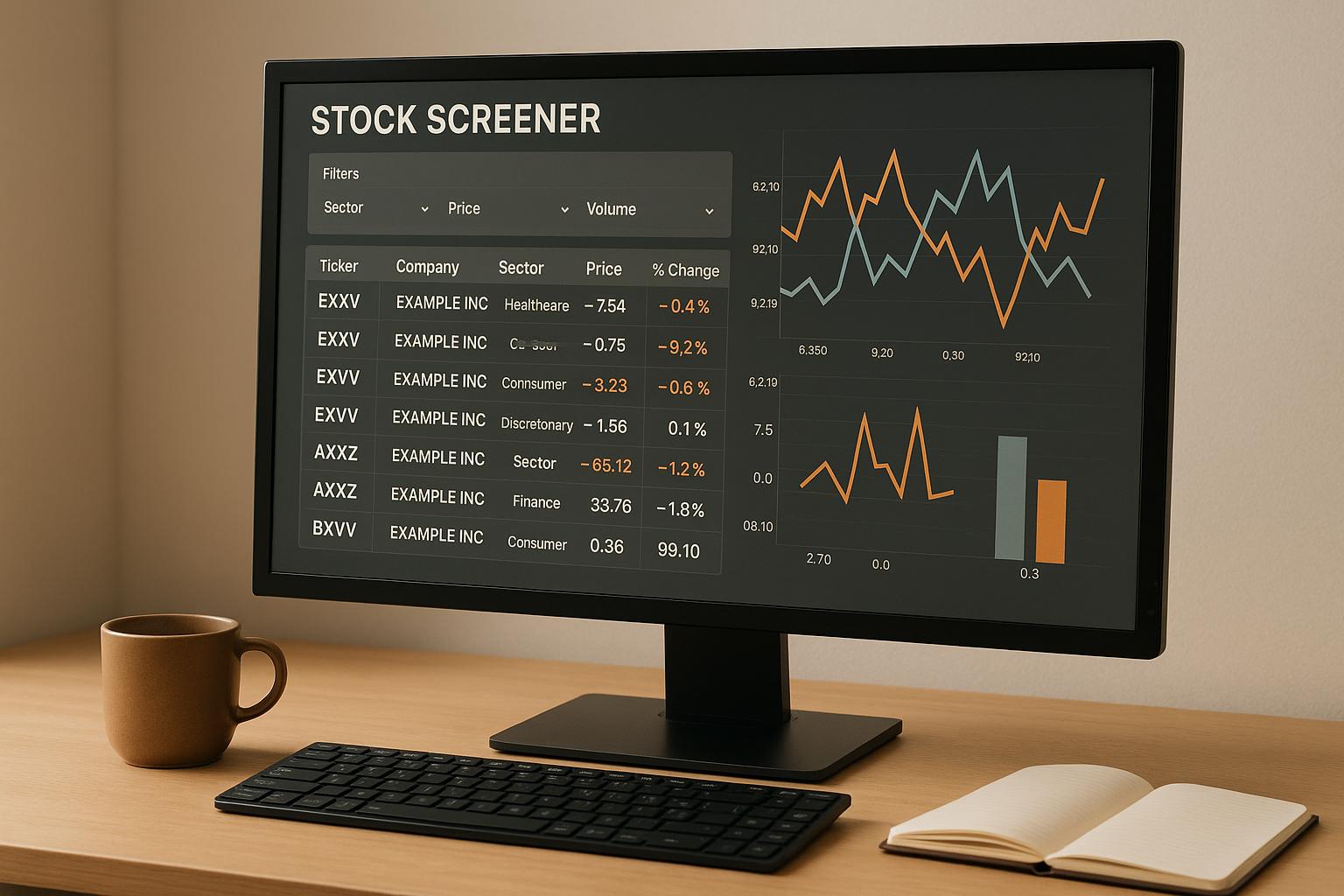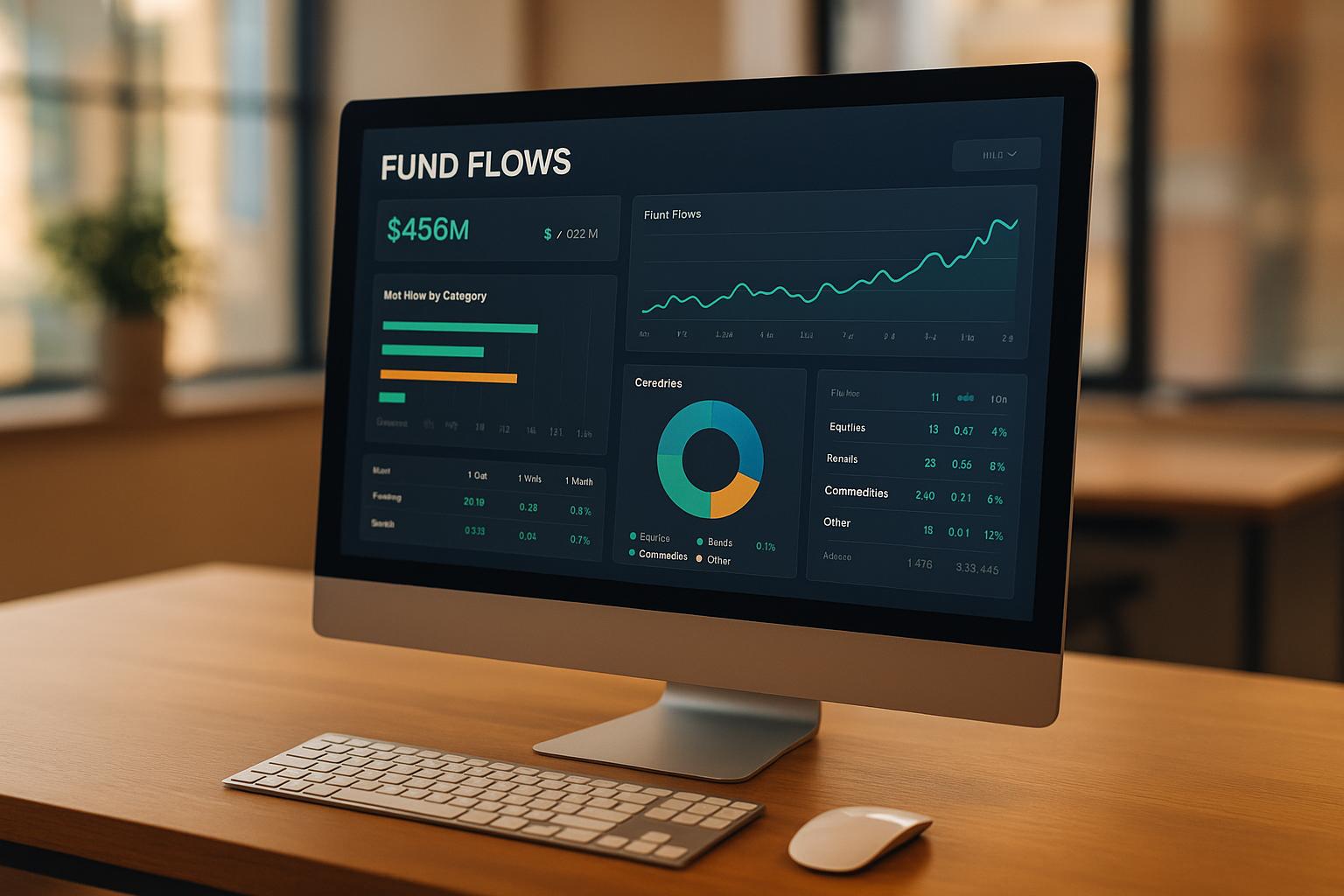AI is transforming how institutional investors manage risk. These platforms use machine learning and real-time data analysis to identify risks faster and more accurately than older methods. By analyzing both structured data (like market prices) and unstructured data (like news or earnings calls), they provide insights that help investors make better decisions in volatile markets.
Key takeaways:
- Real-time analysis: AI evaluates risks as they happen, not just based on historical trends.
- Broader data sources: Platforms analyze market data, news, social media, and more.
- Scenario testing: They simulate complex market events to prepare for potential disruptions.
- Integration: AI tools work alongside existing systems for smoother operations.
- Challenges: High costs, data quality issues, and regulatory compliance remain hurdles.
For institutional investors, these tools offer faster insights, better risk detection, and improved portfolio management. However, success depends on proper implementation, robust data practices, and skilled human oversight.
AI Governance & Risk Management For Financial Services Industry
Core Features of AI Risk Platforms
AI risk platforms bring a fresh approach to risk management, offering advanced tools that go beyond traditional systems. Their integrated features provide institutional investors with timely insights, helping to improve decision-making and protect portfolios.
Real-Time Data Analysis and Predictive Modeling
One of the standout features of AI risk platforms is their ability to process data in real time, delivering forward-looking insights. Unlike older systems that mainly rely on past trends, these platforms continuously analyze live data from various sources to detect emerging risks as they unfold.
By managing multiple data feeds simultaneously, these platforms ensure decision-makers always have access to the latest information. Using machine learning, predictive models identify patterns and correlations that might be missed by human analysts. These models evolve and improve as new data is introduced, potentially spotting signals that could indicate market downturns.
Natural language processing (NLP) adds another layer of sophistication. It allows platforms to analyze unstructured text data, such as central bank statements or corporate earnings calls, extracting sentiment and identifying key themes that could influence markets. This kind of analysis provides deeper insights into developing risk factors.
The ability to quickly adjust risk metrics is another advantage. Unlike traditional models that update less frequently, AI platforms recalibrate metrics in near real time, allowing portfolio managers to react swiftly to market changes. Scenario analysis further enhances this process, helping institutions prepare for potential shifts in the market landscape.
Scenario Analysis and Stress Testing
AI risk platforms shine when it comes to creating and testing a variety of market scenarios, offering a more dynamic approach to stress testing than traditional methods. They incorporate multiple volatile and interconnected variables, providing a comprehensive view of potential outcomes.
Dynamic scenario generation is a key feature. Instead of relying solely on historical data, these platforms simulate complex situations by combining multiple factors. For instance, they can model scenarios involving simultaneous risk events, giving investors a clearer picture of how their portfolios might perform under extreme conditions.
The ability to assess tail risk events - those rare but severe market movements - is another strength. By analyzing non-linear relationships between assets, these platforms help illustrate how correlations between factors might shift during times of market stress.
Multi-factor stress testing takes this a step further, evaluating how portfolios would respond to combined risks such as interest rate changes, credit spread fluctuations, currency volatility, and liquidity challenges. This approach provides a more complete understanding of portfolio resilience.
AI platforms also account for risks over different time horizons, from intraday fluctuations to long-term trends. This allows investors to see how a portfolio’s risk profile might evolve over time. Results are typically displayed on interactive dashboards, enabling risk managers to dive into specific exposures, pinpoint potential loss drivers, and make more informed decisions.
Integration with Existing Systems
For AI-driven insights to be truly effective, they need to integrate seamlessly with an organization’s existing systems. AI risk platforms are designed to work alongside portfolio management tools, compliance systems, and other essential software, ensuring that advanced analytics become an integral part of daily operations.
Robust API connectivity allows for smooth data sharing between systems, while data standardization ensures consistency across different formats. By linking to portfolio and order management systems, these platforms ensure that calculations are always based on the most up-to-date and accurate portfolio information.
Integration also enhances workflows. Risk insights become embedded in everyday processes rather than being confined to standalone reports. For example, an AI platform might automatically flag positions nearing risk limits or include risk-adjusted performance metrics in standard reports, making these insights both visible and actionable.
For institutions with strict regulatory requirements, integration with compliance systems is especially valuable. Many AI platforms can automatically generate regulatory reports, maintain audit trails, and issue real-time alerts when risk thresholds are close to being breached.
Finally, user-friendly design plays a crucial role. Customizable dashboards tailored to existing workflows make it easy for managers to access critical data, whether they’re in the office or on the go. Some platforms even offer white-label options, allowing institutions to integrate AI-driven analytics directly into their own reporting systems.
Benefits and Challenges of AI Risk Platforms
This section delves into the advantages and challenges of AI risk platforms, offering a balanced view to help institutional investors make thoughtful decisions. While these platforms bring significant benefits to risk management, they also come with hurdles that organizations must address to fully realize their potential.
Benefits of AI Risk Platforms
AI risk platforms provide value across various aspects of institutional investing, delivering measurable improvements in efficiency, decision-making, and risk management.
Faster and More Accurate Decision-Making is one of the standout benefits. These platforms can process immense amounts of data in seconds, uncovering hidden patterns and market signals that might otherwise go unnoticed. This speed and precision empower risk managers to act quickly and develop strategies that can drive higher returns.
Streamlined Operations and Cost Savings are another key advantage. By automating repetitive tasks, AI allows risk teams to concentrate on more complex analyses. This shift not only reduces operational overhead but also enables experts to focus on higher-value activities.
Sophisticated Portfolio Management becomes achievable with AI. These platforms offer a complete view of a portfolio, shedding light on performance drivers and potential risks, including factors like environmental, social, and governance (ESG) metrics. With AI insights, portfolio managers can make timely adjustments to allocations and liquidity, staying agile in fluctuating market conditions.
Comprehensive Risk Analysis is another strength. Unlike traditional models, AI tools can identify complex, non-linear relationships between assets and monitor a variety of factors, from credit spreads to currency fluctuations. This broader perspective helps create a more detailed understanding of portfolio exposure.
However, even with these advantages, AI risk platforms have their share of challenges.
Challenges and Limitations
The adoption of AI in risk management is not without obstacles, and institutions need to navigate these carefully to maximize the platform's effectiveness.
Data Quality and Reliability are critical concerns. Since AI models rely on the data they process, poor-quality or incomplete data can lead to inaccurate results. Institutions must invest in strong data governance practices and validation systems to ensure accuracy. Managing diverse data feeds also demands advanced infrastructure and expertise.
Bias and Lack of Transparency in AI models can complicate their use. Historical data biases can unintentionally influence AI algorithms, resulting in skewed assessments. Additionally, the complexity of some machine learning models makes it difficult for managers to understand how conclusions are reached, which can pose challenges for regulatory reporting and internal governance.
Regulatory Compliance is becoming increasingly complex as AI models grow more advanced. Financial regulators demand rigorous validation, bias testing, and continuous monitoring of AI tools. Meeting these requirements while maintaining the flexibility of AI-driven systems requires significant oversight and investment in compliance frameworks.
Human Expertise Remains Essential, even with automation. Skilled professionals are needed to interpret AI-generated insights, validate outputs, and make final decisions. This means ongoing training and development are crucial to ensure teams can effectively work alongside AI.
High Implementation Costs can also be a barrier. Beyond the expense of acquiring the platform, institutions must consider the costs of upgrading data infrastructure, training staff, integrating systems, and maintaining the technology. These efforts can disrupt existing workflows temporarily and require substantial IT resources.
Comparison Table: AI Risk Platforms vs. Traditional Risk Management Tools
The table below highlights key differences between AI platforms and traditional risk management tools:
| Criteria | AI Risk Platforms | Traditional Risk Management Tools |
|---|---|---|
| Processing Speed | Real-time analysis with continuous updates | Batch processing, typically daily or weekly |
| Data Handling | Handles structured and unstructured data | Limited to structured data |
| Predictive Capability | Advanced modeling with machine learning | Relies on historical trend analysis |
| Scalability | Automatically handles growing data volumes | Requires manual system upgrades |
| Scenario Testing | Dynamic scenarios with complex variables | Static scenarios based on past events |
| Implementation Cost | High upfront costs, lower ongoing expenses | Lower initial cost, higher manual labor costs |
| Human Resource Needs | Requires AI expertise, reduces routine tasks | Relies on manual analysis and interpretation |
| Accuracy in Volatile Markets | Adapts quickly to changes | May lag in fast-changing conditions |
| Transparency | Complex algorithms, harder to interpret | Clear, straightforward methodologies |
sbb-itb-2e26d5a
How to Choose and Implement an AI Risk Platform
Setting up an AI risk platform isn’t something you can jump into without careful planning. It starts with understanding your organization’s current capabilities and needs, then selecting the right technology partner, and finally creating workflows that make the most of the platform - all while staying compliant with regulations.
Assessing Your Organization's Needs and Readiness
Before picking a platform, take a step back and evaluate where your organization stands in terms of risk management and AI readiness.
- Start with a systems audit. Look closely at how your current risk management tools function. Map out your data workflows to identify areas where AI could step in, like automating repetitive tasks or improving decision-making accuracy.
- Check your data infrastructure. AI platforms thrive on clean, accessible data. Review your data sources - whether they’re market feeds, portfolio systems, or regulatory databases. Assess whether your data is centralized or scattered across systems, and ensure its quality is up to par. Poor data can derail even the most advanced AI tools.
- Gauge your team’s technical skills. Conduct a survey to understand how comfortable your staff is with AI tools. Identify skill gaps and decide if you’ll need external expertise to manage the implementation process.
- Review regulatory requirements. Make sure the platform you’re considering aligns with transparency, model validation, and audit trail standards. This is especially important in heavily regulated industries like finance.
Once you’ve assessed your internal readiness, you can move on to evaluating specific platform features.
Selecting the Right Platform
Choosing the right AI risk platform means finding one that fits your technical and operational needs while being scalable and reliable.
- Look for seamless integration. A survey found that 37% of finance executives prioritize platforms that integrate easily with existing systems. Opt for platforms with robust APIs to avoid disrupting your workflows.
- Think about scalability. The platform should grow with your organization, enhancing your current systems rather than replacing them entirely. This way, you can build on your existing investments while adding AI capabilities.
- Ensure compatibility with your data. Some platforms handle structured financial data well but may struggle with unstructured data like news feeds or regulatory documents. Pick a platform that can manage all the data types you rely on.
- Check the vendor’s track record. Look for providers with experience working with organizations like yours. Request case studies or references to see how they’ve handled similar implementations.
- Use research tools. Resources like the Best Investing Tools Directory (https://bestinvestingtools.com) can provide detailed reviews and comparisons, helping you make an informed decision.
- Focus on transparency. Given the scrutiny around AI in finance, choose platforms that explain how their models reach conclusions. This is critical for compliance and internal governance.
Once you’ve selected a platform, it’s time to focus on implementation and ongoing monitoring.
Best Practices for Implementation and Monitoring
A successful implementation balances innovation with risk management and regulatory compliance. Here’s how to approach it:
- Plan the integration roadmap. Set clear objectives and success metrics. Start with small, high-impact use cases to build confidence and show results early.
- Centralize your data. Combine all your data sources into a single repository with standardized formats and validation checks. APIs can help connect different systems and ensure smooth data flow.
- Pilot the platform. During a trial phase, run the AI system alongside your current processes. Compare its results to your baseline metrics to fine-tune the system before full deployment.
- Create governance frameworks. Human oversight is essential for critical decisions. Define when and how human intervention is required to validate AI recommendations.
- Train your team. Help your staff understand how AI tools can complement their expertise, freeing them from routine tasks to focus on strategic work.
- Monitor and refine. Regularly review the platform’s performance against benchmarks. Update models with fresh data, adjust automation thresholds, and tweak validation rules as conditions change.
- Prioritize security. Build robust security measures into every stage of the AI lifecycle, from data collection to deployment. This ensures the integrity of your systems.
- Manage change effectively. Involve stakeholders early and communicate clearly how AI will improve workflows and decision-making.
The time it takes to implement an AI risk platform will depend on your existing systems and the scope of the project. Success hinges on preparation, realistic goals, and a commitment to ongoing improvement.
Conclusion: The Future of AI in Institutional Risk Management
AI-powered risk platforms are transforming how institutions approach risk management, shifting the focus from reacting to problems toward proactive, data-informed strategies.
The capabilities discussed earlier are already influencing how investment decisions are made. Institutional investors adopting these technologies can respond to market changes more quickly and evaluate risks with greater precision. But these benefits come with a caveat: success depends on proper implementation.
To make the most of AI risk platforms, institutions must plan carefully. This includes evaluating their data infrastructure, investing in employee training, and focusing on how these tools can complement - rather than replace - human expertise.
Looking ahead, these platforms will only grow more advanced. Machine learning will sharpen its ability to detect subtle market trends, and integration features will make the technology easier to adopt for organizations of varying sizes. Meanwhile, regulatory frameworks are adapting to the rise of AI in risk management, offering clearer compliance standards and validation processes.
For institutions weighing the adoption of this technology, the key questions are no longer "if" but "when" and "how" to proceed. Those who act thoughtfully and with purpose will be better equipped to navigate the complexities of modern markets with precision and confidence.
FAQs
How do AI risk platforms enhance decision-making for institutional investors compared to traditional tools?
AI risk platforms provide institutional investors with a more efficient and precise way to handle market risks. These platforms analyze massive datasets in real time, uncovering patterns, forecasting potential risks, and adjusting strategies as markets shift. This level of capability often surpasses what traditional tools can achieve.
On top of that, AI takes over repetitive tasks, simplifies workflows, and minimizes human error. These advantages lead to improved investment results and reduced operational expenses. By delivering actionable insights and speeding up decision-making, AI platforms enable investors to navigate the ever-changing market landscape with greater consistency and effectiveness.
What challenges do institutional investors face when adopting AI risk platforms, and how can they address them?
Institutional investors face several hurdles when integrating AI risk platforms into their workflows. Key challenges include ensuring accurate data, tackling algorithmic bias, staying on top of regulatory compliance, and addressing cybersecurity threats. These issues can make it difficult to seamlessly adopt AI tools into their operations.
To address these challenges, organizations should focus on establishing strong data governance practices to guarantee reliable and fair data inputs. Staying in close communication with regulators can help institutions adapt to shifting compliance standards. Equally important is fortifying cybersecurity protocols to protect sensitive financial information from potential breaches.
How do AI-powered risk platforms ensure data quality and minimize bias for accurate risk assessments and regulatory compliance?
AI-powered risk platforms tackle issues like data quality and bias through strong data management practices. They establish clear standards for data accuracy, keep a close eye on data sources, and conduct regular audits to spot and address potential biases. By incorporating algorithms designed to minimize bias and applying techniques to mitigate it, these platforms aim to deliver risk assessments that are both accurate and aligned with regulatory standards.
Transparency is another key focus. These platforms meticulously document their data processing methods and model development processes. This approach not only builds trust with institutional investors but also ensures compliance with accountability and fairness regulations.



